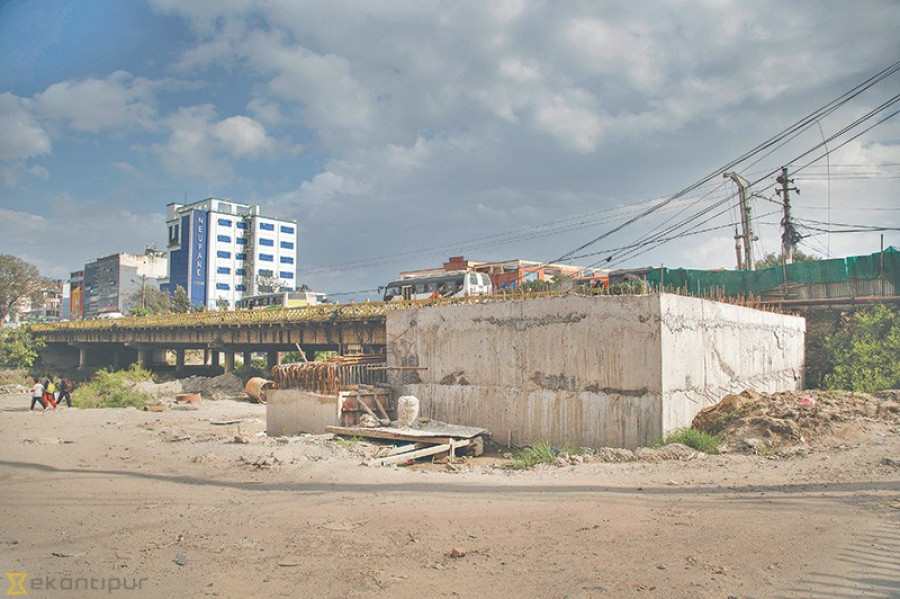Valley
Another Pappu Construction bridge found to be substandard
A parliamentary committee discovered that the bridge over Bagmati River in Tinkune had used faulty piles
Prithvi Man Shrestha
Yet another bridge built by the much-maligned Pappu Construction, which has an unenviable track record in building poor quality infrastructure, has been found to be substandard.
The Parliamentary Development and Technology Committee, on Friday, discovered that the construction company had built a “substandard underground structure” for the bridge, which is under construction, over the Bagmati River at Tinkune in Kathmandu. The committee is pursuing legal action against the company.
The committee, which conducted a field study and interacted with locals and experts, found that two piles out of 16 in the foundation on the Tinkune side of the bridge had cracked in a technical test. Piles are long concrete poles that support a bridge. They are hammered into the ground until they reach a hard rock or soil layer.
For the Tinkune bridge, one other pile was found to be significantly shorter, at 16.5 metres, than the approved design, which had provisioned that the length should be 29.5 metres.
The bridge is being constructed upstream of an operational bridge while Pappu is building another bridge downstream. The two bridges are being constructed under a single financial package.
According to the committee’s report, after finding issues with three piles, the Kathmandu Valley Road Expansion Project had last year instructed that work on the project be restarted only after fixing the substandard piles. However, the company ignored the project office’s instructions and went ahead with building a sub-structure.
In response, the project office had stopped the contractor from working.
“Work has been suspended on the bridge since October last year,” said Arjun Aryal, chief of the Kathmandu Valley Road Expansion Project.
The project office had instructed the company to submit a redesign of the bridge. As the office was unsatisfied with the redesign, it was sent to the Institute of Engineering for validation.
Both bridges should have been completed by June last year but progress remains slow. The project office has not yet extended Pappu’s deadline
even though it had proposed an extension until June 2020, citing a delay in design approval.
“If Pappu fails to correct its design and restart work, we will move forward with terminating the contract or handing other penalties,” said Keshav Kumar Sharma, director general of the Department of Road.
Pappu Construction, along with founder and suspended lawmaker Hari Narayan Rauniyar and his son Sumit Rauniyar, are facing corruption charges over a similarly faulty construction of a bridge over the Babai river in Jabbighat, Bardiya.
On March 23, the Public Procurement Monitoring Office had blacklisted the company, barring it from participating in any public procurement bids for three years as per the request of Sikta Irrigation Project. Pappu Construction had completed just 6.96 percent of work in the Dunduwa Irrigation System of the Sikta Irrigation Project when its deadline expired in October last year.
The Department of Roads also has not accepted the handover of a bridge built over the Bishnumati river at Kalimati, Kathmandu, citing substandard construction. Pappu had built the bridge over a year ago.
“Pappu has a bad track record and nobody has any sympathy for this company. But he [Hari Rauniyar] has been managed to escape governmental action, as he keeps getting court orders in his favour,” said Sharma.
Efforts to contact founder Rauniyar and son Sumit were unsuccessful.
Pappu’s actions in the construction of the Tinkune bridge mimic what it did with the Kalimati bridge. It had ignored written warnings to not continue work by a consultant who had discovered that the contractor, a joint venture of ZIEC and Pappu Construction, had used substandard cables of diameter 15.2mm against the approved design of 15.7mm.
Pappu Construction holds construction contracts worth around Rs 15 billion but has a long and troubled history of poor performance.




 10.12°C Kathmandu
10.12°C Kathmandu











